BDK "Konstantin Olshansky." Destiny at a crossroads. Part of 1
The design itself was carried out in fraternal Poland. The chief designer was the Polish shipbuilder O. Vysotsky, the chief observer from the Soviet Navy was the captain of the 1 rank B.M. Molozhozhnikov (later on, civilian specialist MI Rybnikov replaced him in this position of observer), and L.V. Lugovin.
BDK "Konstantin Olshansky"
The construction of the ships, now practically constituting the core of the amphibious fleet, was also carried out in the Polish shipyard Gdansk at the shipyard Stocznіa Polnocna (translated as “Northern Shipyard”). This shipyard was founded in 1945 year, and since 50-ies engaged in the construction of mainly warships for the fleets of Poland, GDR, USSR, Bulgaria and Yugoslavia. Today, the shipyard was bought by Remontowa SA, and it is called Remontowa Shipbuilding. By the way, the predecessors of Konstantin Olshansky, the ships of the project 770, 771 and 773 were also built on this Polish shipyard.
The first lead ship of the 775 SDK-47 series was built in 1974. As construction progressed, improvements were made in the project, so the first original series, consisting of 12 ships, was completed by 1978 year. According to the NATO classification, these amphibious assault vehicles received the Polish name “Ropucha” (“Toad”).
After the modification of the 775 project, the ships of the 775 II project with the corresponding NATO name Ropucha II, which were built in Gdansk up to the 1992 year, went to the series. This series was different from the ancestor of another radar.
The development of the project in the form of the third series of project 775 was specifically designed for Tanks T-80, but, in fact, they were already slightly different ships, so they passed the project with the number 778. However, the collapse of the Soviet Union put an end to both the project and the entire series. The lead ship of the 778th project, which according to some sources should have been named in honor of Vice Admiral Ivan Ivanovich Gren, even managed to lay down. But at the same rate as “decommunization” was turning into industrial degradation, the already laid ship was cut into metal by 1993.
All built in Gdansk BDK intended only for the Soviet fleet. The exception was only one BDK No. 139, then transferred to the friendly People's Democratic Republic of Yemen in 1979, when our naval forces were based with access to the Indian Ocean and Gulf of Aden in order to protect the newly minted "friends." True, the sense of the "royal" gift was a bit. In 1986, a bloody civil war broke out.
The BDK of the first and second series of the 775 project are multi-deck flat-bottomed amphibious assault ships of the ocean zone. For these ships, a cargo (tank) deck, which runs the entire length, is characteristic, thanks to which the loading and unloading of armored vehicles could be carried out both from the stern and from the bow. Such a design is called the Ro-Ro (or Rocker, in civil shipbuilding it is a cargo-passenger ships, often ferries). The silhouette of a ship with a forecastle and developed aft superstructure is more than recognizable.
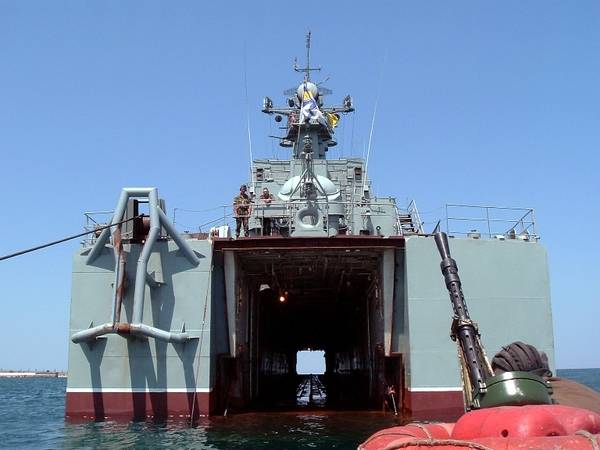
These ships are intended to transport amphibious forces and disembark them both on the equipped and on the unequipped coast. BDK is also able to provide fire support to the landing party. The ship can be used both to evacuate the population and to deliver humanitarian supplies. By the way, these ships had to carry out the latest actions in practice, but more on that later. As a rule, the BDK operate as part of the ship's amphibious assault group, but it was understood that they are capable of performing their functions independently without the cover ships.
BDK 775 and 775 II are designed for use in one of the following loading options: either 150 man of troops and 10 of main battle tanks of type T-55 with crews of 40 man; or 12 amphibious tanks PT-76 with crews of 36 people; or a unit consisting of three main battle tanks of T-55 type with 12 crews, three 120-mm mortars with crews, three combat vehicles with crews (command and staff vehicles), four ZIL-130 vehicles, four GAZ-66 vehicles and one passenger SUV GAZ-69. On the ship, there is a place to accommodate the landing party to 190 (according to other data, the number can be brought to 225 people, given the hold). The ship is able to transport cargo weighing 650 t to a distance of 4700 miles.
According to the testimony of some of the "visitors" of the ship, the interior is more than modest. Thus, the ceiling height (lining the inside of the ceiling of residential premises) is no more than 2 meters, and in fact, taking into account the space savings between the beds located in three tiers, the paratrooper is always packed, like a cartridge holder. And such transportation can last much longer than one week.
The tank bilge had the following characteristics: length 95 m, width of the bow 6,5 m, width of the stern 4,5 m, height along the diametrical plane 4 m. The landing is carried out with the help of a nasal landing device even with rough seas up to 4 points.
Directly BDK "Konstantin Olshansky" was born under the license number BDK-56. By the way, this ship is a kind of elder brother of two other landing ships operating on the Black Sea - “Caesar Kunikov” and “Novocherkassk”.
The main performance characteristics of the Konstantin Olshansky BDK:
The standard displacement is 2768 tons, the total displacement is 4012 tons.
112,5 meter length, 15,01 meter width, 4,26 meter draft.
Full speed - 18 knots (power plant - 2 diesel engine "Zgoda-Sulzer" 16ZVB40 / 48 for 9600 hp. Each).
3500 miles sailing range for 16 nodes or 6000 miles for 12 nodes;
Autonomy about 30 days.
The total number of crew - 98 people.
And now about the armament of the BDK. As an artillery weapon, the Konstantin Olshansky carries two twinned 57-mm AK-725 installations. One is set before the wheelhouse, the second at the stern. Artstanovki, as they say, with history. They were developed as early as 60's, and were put into service as early as 1964. Production of plants was stopped in the 1988 year, so the last three ships of the 775 project were armed with more modern AK-176 and two 30-mm six-barrel AK-630М installations.
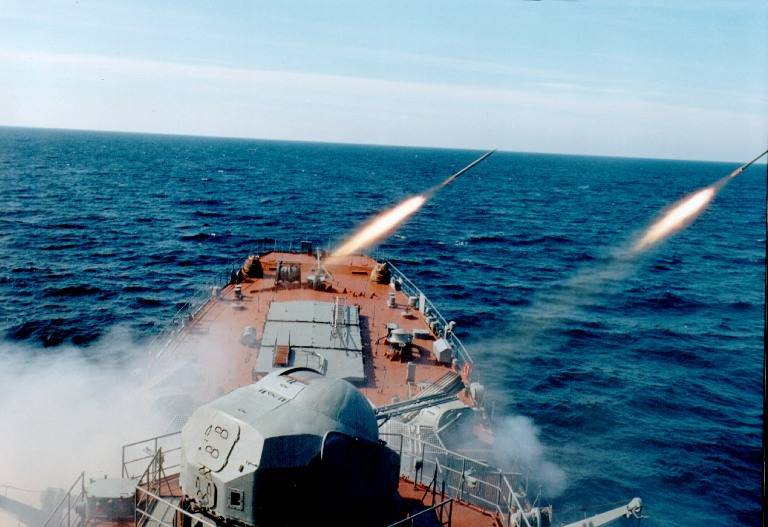
And in the clean ... sea system "Grad"
For the fire support of the assault force, the ship was equipped with two Grad-M A-215 multiple launch rocket systems of 122 mm caliber. The 40-barrel system А-215 is capable of throwing unpleasant surprises in the form of high-explosive fragmentation missiles 9М22У at a distance of up to 20-thousand meters.
Also, to enhance the security of the BDK, Strela-3 MANPADS were included in the mandatory kit, in addition to stationary weapons.
That is how the Red Banner Black Sea Fleet of the USSR entered into service in the BND-56 of the USSR in 1985. In 1991, the year of the license ship got its present name - "Konstantin Olshansky". Konstantin Fedorovich himself, after whom the ship was named, was born in 1915 in the Kharkov province and was an ordinary car mechanic before the war. After being drafted, he joined the Red Army on the Black Sea Fleet. Olshansky participated in the defense of Sevastopol and Yeisk, liberated Taganrog and Mariupol.
In 1944, commanding a tiny detachment of paratroopers in 68, Olshansky seized the port of Nikolaev and, defending the object for two days, pulled the considerable Nazi forces to him and this greatly facilitated the task of the advancing Soviet troops. During the operation, a detachment of Konstantin Fyodorovich destroyed the Nazis to 700. Apart from the fact that the sappers of the detachment retained most of the infrastructure of the port, which the Nazis intended to blow up.
Landing with the same type BDK
Olshansky died in that battle. He was posthumously awarded the title Hero of the Soviet Union. Konstantin Fedorovich was buried in a mass grave in Nikolaev in the 68 park of paratroopers. There, as I know, the hands of the Kiev junta have not yet reached.
However, in the same year 1991 allegedly entered into force the so-called Act of the Proclamation of Independence of Ukraine. This marked a massive razderbanivanie Soviet national property, in this case the Black Sea Fleet, from the infrastructure to the ships directly. The thought itself was not even capable of penetrating into the greedy skull boxes, why a ship was needed, what tasks it would solve, etc. By the way, it was then that the purely doctrinaire "basis" of the Ukrainian fleet was laid, which brought it to its present state. Mriya about "spaceships plowing the Bolshoi Theater," replaced the harsh reality.
The new authorities of Ukraine laid claim to all the ships of the fleet, as in the well-known joke “a tse on the land”. Therefore, provocations and open attempts at forceful seizure have become commonplace for the Konstantin Olshansky BDK.
To be continued ...
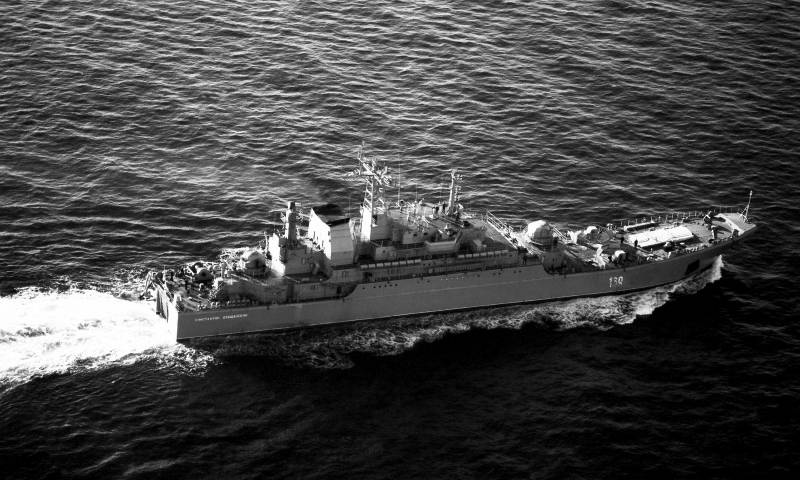
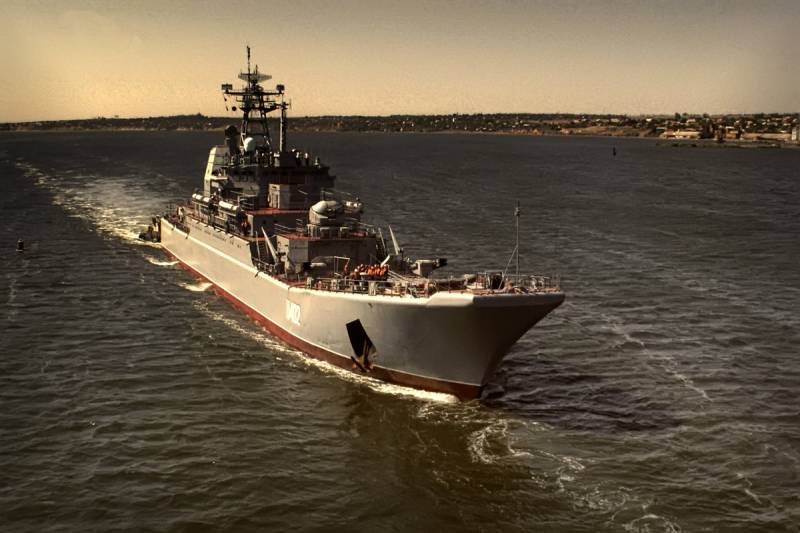
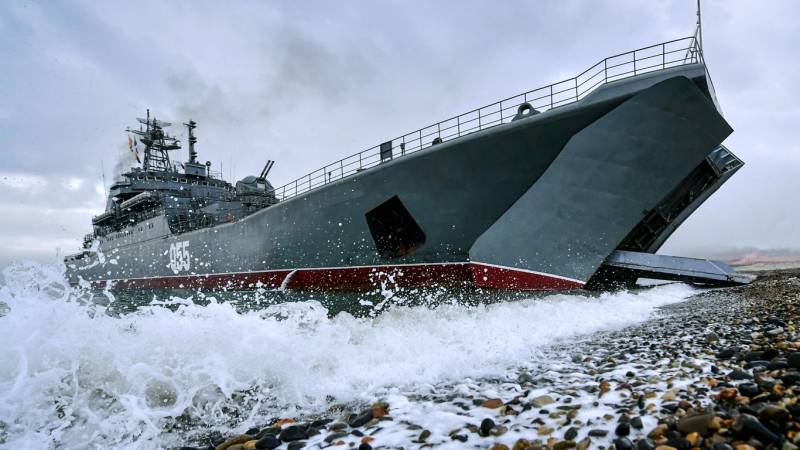
Information